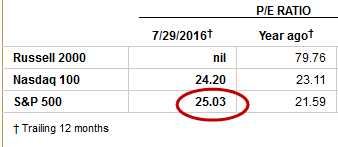John J. Xenakis
We truly live in magical times.
Earnings have been falling, but the stock market keeps going up.
It's as if the law of gravity has been repealed. Or perhaps the alchemists have finally found a way to turn lead into gold.
Let's start, as I often do, with price/earnings ratios, also called stock valuations.
According to Friday's Wall Street Journal, the S&P 500 Price/Earnings index (stock valuations index) on Friday morning (July 29) was at an astronomically high 25.03. This is far above the historical average of 14, indicating that the stock market bubble is still growing, and could burst at any time. Generational Dynamics predicts that the P/E ratio will fall to the 5-6 range or lower, which is where it was as recently as 1982, resulting in a Dow Jones Industrial Average of 3000 or lower.

The last time I wrote about this, the P/E ratio was a mere 24.23. That astronomically high number has now shot up to 25.03. That's because stock prices have been staying steady or going up, while earnings have been falling so that the ratio (price/earnings) goes up.
Why are stock prices going up? It's because central banks around the world are "printing money" through quantitative easing (QE) at huge tsunami rates.
According to Deutsche Bank, the European Central Bank (ECB) and Bank of Japan (BOJ) are together buying around $180 billion of assets a month.
And that's not the end. The ECB is expected to increase its QE to $110 billion, and the BOJ is expected to increase its QE program to $80 billion. The Bank of England (BoE) is expected to reactivate its QE program, and supply $197 billion more QE.
It's mind-boggling beyond anything in history. There's never been anything like it.
It's a credit bubble of such enormous size that it's impossible to predict the enormity of the disaster that will ensue when it finally implodes -- which it certainly will.
Here's a quote from someone on tv described as a "tenured university professor of economics at University of Maryland." It's one the stupidest things I've ever heard, so I transcribed it:
"Companies are learning how to use capital much more effectively. So central banks may have printed a lot of money, they are using money more efficiently, which lowers the price of capital, and essentially raises P/E ratios. We are now trading at about the 25 year average, but the long-term average the moving average over time is trending up. My feeling is that we could be looking at P/E ratios that are stable at 30 or 35 long-term. The average historically is 25, and that's where we are now."
Since I hear stupid things all the time on financial news channels, let's pull this apart for educational purposes.
First, the P/E ratio now is around 25, but historically it's around 14, not 25. You'd think a "tenured professor of economics" would have a clue about that.
Next, a P/E ratio is not stable at 25, and will certainly never be stable at 30-35. So let's explain what's going on here, and why the tenured professor is so confused.
The P/E ratio is actually the reciprocal of a low-risk investment yield or interest rate. That is, the historical value of the P/E ratio is 14, and its reciprocal is earnings/price, which is historically around 1/14, or around 7%. This value, 7%, seems to be some sort of natural constant, the natural value that investments pay in "normal" times. That's why, in the decades after World War II, you had investments that paid around 7%, and you had mortgage rates around 7%. Savings accounts paid a little less, because banks had to make money, and government bonds paid a little less, because they were considered as safe as cash.
So now you have a P/E ratio around 25, which corresponds to a 4% investment yield, is far below the "natural" value of 7%, but is possible because bond yields are now close to zero or are negative in many parts of the world. At such low yields, an average investor (without access to the huge floods of government money) is not willing to invest his money. That's one reason why investments are so low today. Who wants to invest in a shoe factory, if the most you can get is 4%, and you could lose everything if the shoe factory fails?
So the tenured university economics professor says that he thinks the P/E ratio will stabilize around 30-35, pushing the investment yield down to 3%. That would only happen if much more of the world's government bonds go to negative interest rates, and that can't continue forever, meaning that a 30-35 P/E ratio is far from stable.
So this really is truly a magical, marvelous time to be alive. Enjoy it while it lasts, Dear Reader.
DYI Comments: Will the U.S. stock "mean invert" Shiller PE10 from the secular 2000 top at 43.77 all the way under 10? If history is any sort of the guide most likely "YES." When this bubble bursts the U.S. will go into a massive deflationary depression smash. Shiller PE10 is currently at 26.95 a high flying market all propelled by cheap money provided by world wide central banks. Many years after it bursts economic historians will mark this period as a redo of the tulip bulb craze of Holland or England's South Sea Company.
So hang onto your hats and your cash better values are ahead!
DYI
No comments:
Post a Comment